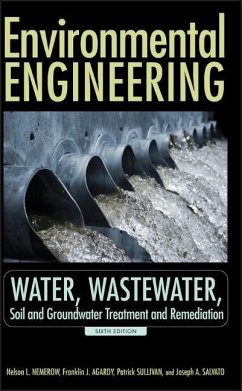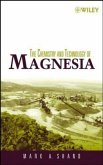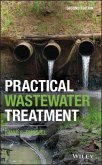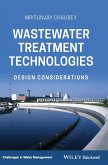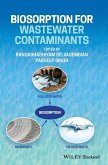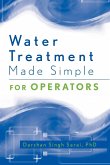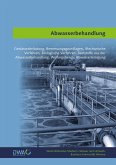Nelson L. Nemerow, Franklin J. Agardy, Joseph A. Salvato
Environmental Engineering
Water, Wastewater, Soil and Groundwater Treatment and Remediation
Nelson L. Nemerow, Franklin J. Agardy, Joseph A. Salvato
Environmental Engineering
Water, Wastewater, Soil and Groundwater Treatment and Remediation
- Gebundenes Buch
- Merkliste
- Auf die Merkliste
- Bewerten Bewerten
- Teilen
- Produkt teilen
- Produkterinnerung
- Produkterinnerung
First published in 1958, Salvato's Environmental Engineering has long been the definitive reference for generations of sanitation and environmental engineers. Approaching its fiftieth year of continual publication in a rapidly changing field, the Sixth Edition has been fully reworked and reorganized into three separate, succinct volumes to adapt to a more complex and scientifically demanding field with dozens of specializations.
Updated and reviewed by leading experts in the field, this revised edition offers new process and plant design examples and added coverage of such subjects as urban…mehr
Andere Kunden interessierten sich auch für
![The Chemistry and Technology of Magnesia The Chemistry and Technology of Magnesia]() Mark A. ShandThe Chemistry and Technology of Magnesia156,99 €
Mark A. ShandThe Chemistry and Technology of Magnesia156,99 €![Practical Wastewater Treatment Practical Wastewater Treatment]() David L. RussellPractical Wastewater Treatment128,99 €
David L. RussellPractical Wastewater Treatment128,99 €![Wastewater Treatment Technologies Wastewater Treatment Technologies]() Mritunjay ChaubeyWastewater Treatment Technologies130,99 €
Mritunjay ChaubeyWastewater Treatment Technologies130,99 €![Biosorption for Wastewater Contaminants Biosorption for Wastewater Contaminants]() Biosorption for Wastewater Contaminants231,99 €
Biosorption for Wastewater Contaminants231,99 €![Water Treatment Made Simple Water Treatment Made Simple]() Darshan Singh SaraiWater Treatment Made Simple93,99 €
Darshan Singh SaraiWater Treatment Made Simple93,99 €![Abwasserbehandlung Abwasserbehandlung]() Abwasserbehandlung80,00 €
Abwasserbehandlung80,00 €![Gewässerschutz und Abwasserbehandlung Gewässerschutz und Abwasserbehandlung]() Klaus Görner / Kurt Hübner (Hgg.)Gewässerschutz und Abwasserbehandlung59,99 €
Klaus Görner / Kurt Hübner (Hgg.)Gewässerschutz und Abwasserbehandlung59,99 €-
-
-
First published in 1958, Salvato's Environmental Engineering has long been the definitive reference for generations of sanitation and environmental engineers. Approaching its fiftieth year of continual publication in a rapidly changing field, the Sixth Edition has been fully reworked and reorganized into three separate, succinct volumes to adapt to a more complex and scientifically demanding field with dozens of specializations.
Updated and reviewed by leading experts in the field, this revised edition offers new process and plant design examples and added coverage of such subjects as urban and rural systems. Stressing the practicality and appropriateness of treatment, the Sixth Edition provides realistic solutions for the practicing public health official, water treatment engineer, plant operator, and others in the domestic and industrial waste treatment professions.
This volume, Environmental Engineering: Water, Wastewater, Soil and Groundwater Treatment and Remediation, Sixth Edition, covers:
Water treatment
Water supply
Wastewater treatment
Hinweis: Dieser Artikel kann nur an eine deutsche Lieferadresse ausgeliefert werden.
Updated and reviewed by leading experts in the field, this revised edition offers new process and plant design examples and added coverage of such subjects as urban and rural systems. Stressing the practicality and appropriateness of treatment, the Sixth Edition provides realistic solutions for the practicing public health official, water treatment engineer, plant operator, and others in the domestic and industrial waste treatment professions.
This volume, Environmental Engineering: Water, Wastewater, Soil and Groundwater Treatment and Remediation, Sixth Edition, covers:
Water treatment
Water supply
Wastewater treatment
Hinweis: Dieser Artikel kann nur an eine deutsche Lieferadresse ausgeliefert werden.
Produktdetails
- Produktdetails
- Verlag: Wiley & Sons
- 6. Aufl.
- Seitenzahl: 400
- Erscheinungstermin: 20. Januar 2009
- Englisch
- Abmessung: 236mm x 157mm x 23mm
- Gewicht: 669g
- ISBN-13: 9780470083031
- ISBN-10: 0470083034
- Artikelnr.: 25557733
- Herstellerkennzeichnung
- Libri GmbH
- Europaallee 1
- 36244 Bad Hersfeld
- gpsr@libri.de
- Verlag: Wiley & Sons
- 6. Aufl.
- Seitenzahl: 400
- Erscheinungstermin: 20. Januar 2009
- Englisch
- Abmessung: 236mm x 157mm x 23mm
- Gewicht: 669g
- ISBN-13: 9780470083031
- ISBN-10: 0470083034
- Artikelnr.: 25557733
- Herstellerkennzeichnung
- Libri GmbH
- Europaallee 1
- 36244 Bad Hersfeld
- gpsr@libri.de
The Late NELSON L. NEMEROW, PHD, was an environmental engineering and water consultant. He was a professor at the University of Miami and the former head of Environmental Engineering at Syracuse University. He published over 210 technical papers and twenty-three textbooks. FRANKLIN J. AGARDY, PHD, is founding partner of Forensic Management Associates. As a civil engineering professor, he developed San Jose State's graduate program in sanitary engineering. He has written, coauthored, or coedited seven textbooks. PATRICK SULLIVAN, PHD, is founding partner of Forensic Management Associates. Prior to his forensics career, he was a senior environmental analyst at the Jet Propulsion Laboratory at the California Institute of Technology. He has written, coauthored, or coedited five textbooks. The Late JOSEPH A. SALVATO served as a sanitary and public health engineer consultant and assistant commissioner in the Division of Sanitary Engineering for the New York State Department of Health. He was also a Fellow of the ASCE and the APHA and adjunct associate professor at Rensselaer Polytechnic Institute.
Preface xiii
Contributors xv
Chapter 1 Water Supply 1
T. David Chinn
Introduction 1
Groundwater Pollution Hazard 3
Travel of Pollution through the Ground 5
Disease Transmission 10
Water Quantity and Quality 10
Water Cycle and Geology 10
Groundwater Flow 13
Groundwater Classification 16
Water Quality 17
Sampling and Quality of Laboratory Data 26
Sanitary Survey and Water Sampling 30
Sampling Frequency 33
Water Analyses 36
Heterotrophic Plate Count-The Standard Plate Count 37
Bacterial Examinations 38
Biological Monitoring 42
Virus Examination 42
Protozoa and Helminths Examination 43
Specific Pathogenic Organisms 43
Physical Examinations 44
Microscopic Examination 46
Chemical Examinations 48
Drinking Water Additives 68
Water Quantity 69
Water Conservation 70
Water Reuse 75
Source and Protection of Water Supply 77
General 77
Groundwater 88
Dug Well 88
Bored Well 89
Driven and Jetted Well 90
Drilled Well 91
Well Development 93
Grouting 96
Well Contamination-Cause and Removal 99
Spring 101
Infiltration Gallery 101
Cistern 103
Domestic Well-Water Supplies-Special Problems 105
Household Treatment Units (Point-of-Use and Point-of-Entry) 108
Desalination 111
References 118
Bibliography 126
Chapter 2 Water Treatment 133
T. David Chinn
Treatment of Water-Design and Operation Control 133
Introduction 133
Surface Water 134
Treatment Required 135
Disinfection 136
Gas Chlorinator 137
Testing for Residual Chlorine 138
Chlorine Treatment for Operation and Microbiological Control 139
Distribution System Contamination 145
Plain Sedimentation 146
Microstraining 146
Coagulation, Flocculation, and Settling 147
Filtration 149
Slow Sand Filter 149
Rapid Sand (Granular Media) Filter 151
Direct Filtration 157
Pressure Sand Filter 160
Diatomaceous Earth Filter 160
Package Water Treatment Plant 161
Water Treatment Plant Wastewater and Sludge 162
Causes of Tastes and Odors 162
Control of Microorganisms 163
Zebra Mussel and Its Control 169
Aquatic Weed Control 169
Other Causes of Tastes and Odors 170
Methods to Remove or Reduce Objectionable Tastes and Odors 172
Iron and Manganese Occurrence and Removal 182
Corrosion Cause and Control 187
Removal of Inorganic Chemicals 197
Prevention and Removal of Organic Chemicals 201
Water System Design Principles 205
Water Quantity 205
Design Period 206
Watershed Runoff and Reservoir Design 206
Intakes and Screens 208
Pumping 209
Distribution Storage Requirements 210
Peak Demand Estimates 213
Distribution System Design Standards 217
Small Distribution Systems 220
Fire Protection 220
Cross-Connection Control 222
Hydropneumatic Systems 226
Pumps 231
Displacement Pump 231
Centrifugal Pump, Also Submersible and Turbine 233
Jet Pump 235
Air-Lift Pump 235
Hydraulic Ram 236
Pump and Well Protection 237
Pump Power and Drive 237
Automatic Pump Control 239
Water Hammer 239
Rural Water Conditions in the United States 240
Design of a Household Water System 242
Examples 242
Design of Small Water Systems 242
Design of a Camp Water System 255
Water System Cost Estimates 255
Cleaning and Disinfection 257
Wells and Springs 258
Pipelines 260
Storage Reservoirs and Tanks 261
Emergency Water Supply and Treatment 262
Boiling 263
Chlorination 263
Iodine 266
Filtration in an Emergency 267
Bottled, Packaged, and Bulk Water 267
References 269
Bibliography 278
Chapter 3 Wastewater Treatment and Disposal 283
John R. Kiefer
Disease Hazard 283
Criteria for Proper Wastewater Disposal 285
Definitions 285
Small Wastewater Disposal Systems 288
Wastewater Characteristics 289
Soil Characteristics 289
Soil Suitability 290
Pollutant Travel from Septic Systems 291
Soil Percolation Test 291
Sewage Flow Estimates 293
Septic Tank 295
Care of Septic Tank and Subsurface Absorption Systems 299
Subsurface Soil Absorption Systems 301
Absorption Field System 301
Leaching Pit 305
Cesspool 305
Dry Well 306
Small Wastewater Disposal Systems for Unsuitable Soils or Sites 308
General 308
Modified Septic Tank Soil Absorption System 308
Example 309
Capillary Seepage Trench 309
Raised Bed Absorption-Evapotranspiration System 310
Septic Tank Sand Filter System 312
Aerobic Sewage Treatment Unit 315
Septic Tank Mound System 315
Example 1 317
Electric Osmosis System 318
Septic Tank Evapotranspiration System 318
Example 2 320
Water Conservation 321
Sewage Works Design-Small Treatment Plants 322
Disinfection 322
Physical-Chemical Treatment 326
Sedimentation 326
Coagulation/Flocculation 326
Filtration 327
Activated Carbon Adsorption 328
Biological Treatment 328
Wastewater Reuse 334
Wastewater Aerosol Hazard 335
Wastewater Disposal by Land Treatment 336
Advanced Wastewater Treatment 341
Typical Designs for Small Treatment Plants 344
Standard-Rate Trickling Filter Plant with Imhoff Tank 344
High-Rate Trickling Filter Plant with Imhoff Tank 346
Intermittent Sand Filter Plant with Imhoff Tank or Septic Tank 347
Design of Large Treatment Plants 347
Biosolids Treatment and Disposal 352
Cost of Sewage Treatment 357
Industrial Wastes 360
Hazardous and Toxic Liquid Wastes 360
Pretreatment 362
References 363
Bibliography 367
Index 371
Contributors xv
Chapter 1 Water Supply 1
T. David Chinn
Introduction 1
Groundwater Pollution Hazard 3
Travel of Pollution through the Ground 5
Disease Transmission 10
Water Quantity and Quality 10
Water Cycle and Geology 10
Groundwater Flow 13
Groundwater Classification 16
Water Quality 17
Sampling and Quality of Laboratory Data 26
Sanitary Survey and Water Sampling 30
Sampling Frequency 33
Water Analyses 36
Heterotrophic Plate Count-The Standard Plate Count 37
Bacterial Examinations 38
Biological Monitoring 42
Virus Examination 42
Protozoa and Helminths Examination 43
Specific Pathogenic Organisms 43
Physical Examinations 44
Microscopic Examination 46
Chemical Examinations 48
Drinking Water Additives 68
Water Quantity 69
Water Conservation 70
Water Reuse 75
Source and Protection of Water Supply 77
General 77
Groundwater 88
Dug Well 88
Bored Well 89
Driven and Jetted Well 90
Drilled Well 91
Well Development 93
Grouting 96
Well Contamination-Cause and Removal 99
Spring 101
Infiltration Gallery 101
Cistern 103
Domestic Well-Water Supplies-Special Problems 105
Household Treatment Units (Point-of-Use and Point-of-Entry) 108
Desalination 111
References 118
Bibliography 126
Chapter 2 Water Treatment 133
T. David Chinn
Treatment of Water-Design and Operation Control 133
Introduction 133
Surface Water 134
Treatment Required 135
Disinfection 136
Gas Chlorinator 137
Testing for Residual Chlorine 138
Chlorine Treatment for Operation and Microbiological Control 139
Distribution System Contamination 145
Plain Sedimentation 146
Microstraining 146
Coagulation, Flocculation, and Settling 147
Filtration 149
Slow Sand Filter 149
Rapid Sand (Granular Media) Filter 151
Direct Filtration 157
Pressure Sand Filter 160
Diatomaceous Earth Filter 160
Package Water Treatment Plant 161
Water Treatment Plant Wastewater and Sludge 162
Causes of Tastes and Odors 162
Control of Microorganisms 163
Zebra Mussel and Its Control 169
Aquatic Weed Control 169
Other Causes of Tastes and Odors 170
Methods to Remove or Reduce Objectionable Tastes and Odors 172
Iron and Manganese Occurrence and Removal 182
Corrosion Cause and Control 187
Removal of Inorganic Chemicals 197
Prevention and Removal of Organic Chemicals 201
Water System Design Principles 205
Water Quantity 205
Design Period 206
Watershed Runoff and Reservoir Design 206
Intakes and Screens 208
Pumping 209
Distribution Storage Requirements 210
Peak Demand Estimates 213
Distribution System Design Standards 217
Small Distribution Systems 220
Fire Protection 220
Cross-Connection Control 222
Hydropneumatic Systems 226
Pumps 231
Displacement Pump 231
Centrifugal Pump, Also Submersible and Turbine 233
Jet Pump 235
Air-Lift Pump 235
Hydraulic Ram 236
Pump and Well Protection 237
Pump Power and Drive 237
Automatic Pump Control 239
Water Hammer 239
Rural Water Conditions in the United States 240
Design of a Household Water System 242
Examples 242
Design of Small Water Systems 242
Design of a Camp Water System 255
Water System Cost Estimates 255
Cleaning and Disinfection 257
Wells and Springs 258
Pipelines 260
Storage Reservoirs and Tanks 261
Emergency Water Supply and Treatment 262
Boiling 263
Chlorination 263
Iodine 266
Filtration in an Emergency 267
Bottled, Packaged, and Bulk Water 267
References 269
Bibliography 278
Chapter 3 Wastewater Treatment and Disposal 283
John R. Kiefer
Disease Hazard 283
Criteria for Proper Wastewater Disposal 285
Definitions 285
Small Wastewater Disposal Systems 288
Wastewater Characteristics 289
Soil Characteristics 289
Soil Suitability 290
Pollutant Travel from Septic Systems 291
Soil Percolation Test 291
Sewage Flow Estimates 293
Septic Tank 295
Care of Septic Tank and Subsurface Absorption Systems 299
Subsurface Soil Absorption Systems 301
Absorption Field System 301
Leaching Pit 305
Cesspool 305
Dry Well 306
Small Wastewater Disposal Systems for Unsuitable Soils or Sites 308
General 308
Modified Septic Tank Soil Absorption System 308
Example 309
Capillary Seepage Trench 309
Raised Bed Absorption-Evapotranspiration System 310
Septic Tank Sand Filter System 312
Aerobic Sewage Treatment Unit 315
Septic Tank Mound System 315
Example 1 317
Electric Osmosis System 318
Septic Tank Evapotranspiration System 318
Example 2 320
Water Conservation 321
Sewage Works Design-Small Treatment Plants 322
Disinfection 322
Physical-Chemical Treatment 326
Sedimentation 326
Coagulation/Flocculation 326
Filtration 327
Activated Carbon Adsorption 328
Biological Treatment 328
Wastewater Reuse 334
Wastewater Aerosol Hazard 335
Wastewater Disposal by Land Treatment 336
Advanced Wastewater Treatment 341
Typical Designs for Small Treatment Plants 344
Standard-Rate Trickling Filter Plant with Imhoff Tank 344
High-Rate Trickling Filter Plant with Imhoff Tank 346
Intermittent Sand Filter Plant with Imhoff Tank or Septic Tank 347
Design of Large Treatment Plants 347
Biosolids Treatment and Disposal 352
Cost of Sewage Treatment 357
Industrial Wastes 360
Hazardous and Toxic Liquid Wastes 360
Pretreatment 362
References 363
Bibliography 367
Index 371
Preface xiii
Contributors xv
Chapter 1 Water Supply 1
T. David Chinn
Introduction 1
Groundwater Pollution Hazard 3
Travel of Pollution through the Ground 5
Disease Transmission 10
Water Quantity and Quality 10
Water Cycle and Geology 10
Groundwater Flow 13
Groundwater Classification 16
Water Quality 17
Sampling and Quality of Laboratory Data 26
Sanitary Survey and Water Sampling 30
Sampling Frequency 33
Water Analyses 36
Heterotrophic Plate Count-The Standard Plate Count 37
Bacterial Examinations 38
Biological Monitoring 42
Virus Examination 42
Protozoa and Helminths Examination 43
Specific Pathogenic Organisms 43
Physical Examinations 44
Microscopic Examination 46
Chemical Examinations 48
Drinking Water Additives 68
Water Quantity 69
Water Conservation 70
Water Reuse 75
Source and Protection of Water Supply 77
General 77
Groundwater 88
Dug Well 88
Bored Well 89
Driven and Jetted Well 90
Drilled Well 91
Well Development 93
Grouting 96
Well Contamination-Cause and Removal 99
Spring 101
Infiltration Gallery 101
Cistern 103
Domestic Well-Water Supplies-Special Problems 105
Household Treatment Units (Point-of-Use and Point-of-Entry) 108
Desalination 111
References 118
Bibliography 126
Chapter 2 Water Treatment 133
T. David Chinn
Treatment of Water-Design and Operation Control 133
Introduction 133
Surface Water 134
Treatment Required 135
Disinfection 136
Gas Chlorinator 137
Testing for Residual Chlorine 138
Chlorine Treatment for Operation and Microbiological Control 139
Distribution System Contamination 145
Plain Sedimentation 146
Microstraining 146
Coagulation, Flocculation, and Settling 147
Filtration 149
Slow Sand Filter 149
Rapid Sand (Granular Media) Filter 151
Direct Filtration 157
Pressure Sand Filter 160
Diatomaceous Earth Filter 160
Package Water Treatment Plant 161
Water Treatment Plant Wastewater and Sludge 162
Causes of Tastes and Odors 162
Control of Microorganisms 163
Zebra Mussel and Its Control 169
Aquatic Weed Control 169
Other Causes of Tastes and Odors 170
Methods to Remove or Reduce Objectionable Tastes and Odors 172
Iron and Manganese Occurrence and Removal 182
Corrosion Cause and Control 187
Removal of Inorganic Chemicals 197
Prevention and Removal of Organic Chemicals 201
Water System Design Principles 205
Water Quantity 205
Design Period 206
Watershed Runoff and Reservoir Design 206
Intakes and Screens 208
Pumping 209
Distribution Storage Requirements 210
Peak Demand Estimates 213
Distribution System Design Standards 217
Small Distribution Systems 220
Fire Protection 220
Cross-Connection Control 222
Hydropneumatic Systems 226
Pumps 231
Displacement Pump 231
Centrifugal Pump, Also Submersible and Turbine 233
Jet Pump 235
Air-Lift Pump 235
Hydraulic Ram 236
Pump and Well Protection 237
Pump Power and Drive 237
Automatic Pump Control 239
Water Hammer 239
Rural Water Conditions in the United States 240
Design of a Household Water System 242
Examples 242
Design of Small Water Systems 242
Design of a Camp Water System 255
Water System Cost Estimates 255
Cleaning and Disinfection 257
Wells and Springs 258
Pipelines 260
Storage Reservoirs and Tanks 261
Emergency Water Supply and Treatment 262
Boiling 263
Chlorination 263
Iodine 266
Filtration in an Emergency 267
Bottled, Packaged, and Bulk Water 267
References 269
Bibliography 278
Chapter 3 Wastewater Treatment and Disposal 283
John R. Kiefer
Disease Hazard 283
Criteria for Proper Wastewater Disposal 285
Definitions 285
Small Wastewater Disposal Systems 288
Wastewater Characteristics 289
Soil Characteristics 289
Soil Suitability 290
Pollutant Travel from Septic Systems 291
Soil Percolation Test 291
Sewage Flow Estimates 293
Septic Tank 295
Care of Septic Tank and Subsurface Absorption Systems 299
Subsurface Soil Absorption Systems 301
Absorption Field System 301
Leaching Pit 305
Cesspool 305
Dry Well 306
Small Wastewater Disposal Systems for Unsuitable Soils or Sites 308
General 308
Modified Septic Tank Soil Absorption System 308
Example 309
Capillary Seepage Trench 309
Raised Bed Absorption-Evapotranspiration System 310
Septic Tank Sand Filter System 312
Aerobic Sewage Treatment Unit 315
Septic Tank Mound System 315
Example 1 317
Electric Osmosis System 318
Septic Tank Evapotranspiration System 318
Example 2 320
Water Conservation 321
Sewage Works Design-Small Treatment Plants 322
Disinfection 322
Physical-Chemical Treatment 326
Sedimentation 326
Coagulation/Flocculation 326
Filtration 327
Activated Carbon Adsorption 328
Biological Treatment 328
Wastewater Reuse 334
Wastewater Aerosol Hazard 335
Wastewater Disposal by Land Treatment 336
Advanced Wastewater Treatment 341
Typical Designs for Small Treatment Plants 344
Standard-Rate Trickling Filter Plant with Imhoff Tank 344
High-Rate Trickling Filter Plant with Imhoff Tank 346
Intermittent Sand Filter Plant with Imhoff Tank or Septic Tank 347
Design of Large Treatment Plants 347
Biosolids Treatment and Disposal 352
Cost of Sewage Treatment 357
Industrial Wastes 360
Hazardous and Toxic Liquid Wastes 360
Pretreatment 362
References 363
Bibliography 367
Index 371
Contributors xv
Chapter 1 Water Supply 1
T. David Chinn
Introduction 1
Groundwater Pollution Hazard 3
Travel of Pollution through the Ground 5
Disease Transmission 10
Water Quantity and Quality 10
Water Cycle and Geology 10
Groundwater Flow 13
Groundwater Classification 16
Water Quality 17
Sampling and Quality of Laboratory Data 26
Sanitary Survey and Water Sampling 30
Sampling Frequency 33
Water Analyses 36
Heterotrophic Plate Count-The Standard Plate Count 37
Bacterial Examinations 38
Biological Monitoring 42
Virus Examination 42
Protozoa and Helminths Examination 43
Specific Pathogenic Organisms 43
Physical Examinations 44
Microscopic Examination 46
Chemical Examinations 48
Drinking Water Additives 68
Water Quantity 69
Water Conservation 70
Water Reuse 75
Source and Protection of Water Supply 77
General 77
Groundwater 88
Dug Well 88
Bored Well 89
Driven and Jetted Well 90
Drilled Well 91
Well Development 93
Grouting 96
Well Contamination-Cause and Removal 99
Spring 101
Infiltration Gallery 101
Cistern 103
Domestic Well-Water Supplies-Special Problems 105
Household Treatment Units (Point-of-Use and Point-of-Entry) 108
Desalination 111
References 118
Bibliography 126
Chapter 2 Water Treatment 133
T. David Chinn
Treatment of Water-Design and Operation Control 133
Introduction 133
Surface Water 134
Treatment Required 135
Disinfection 136
Gas Chlorinator 137
Testing for Residual Chlorine 138
Chlorine Treatment for Operation and Microbiological Control 139
Distribution System Contamination 145
Plain Sedimentation 146
Microstraining 146
Coagulation, Flocculation, and Settling 147
Filtration 149
Slow Sand Filter 149
Rapid Sand (Granular Media) Filter 151
Direct Filtration 157
Pressure Sand Filter 160
Diatomaceous Earth Filter 160
Package Water Treatment Plant 161
Water Treatment Plant Wastewater and Sludge 162
Causes of Tastes and Odors 162
Control of Microorganisms 163
Zebra Mussel and Its Control 169
Aquatic Weed Control 169
Other Causes of Tastes and Odors 170
Methods to Remove or Reduce Objectionable Tastes and Odors 172
Iron and Manganese Occurrence and Removal 182
Corrosion Cause and Control 187
Removal of Inorganic Chemicals 197
Prevention and Removal of Organic Chemicals 201
Water System Design Principles 205
Water Quantity 205
Design Period 206
Watershed Runoff and Reservoir Design 206
Intakes and Screens 208
Pumping 209
Distribution Storage Requirements 210
Peak Demand Estimates 213
Distribution System Design Standards 217
Small Distribution Systems 220
Fire Protection 220
Cross-Connection Control 222
Hydropneumatic Systems 226
Pumps 231
Displacement Pump 231
Centrifugal Pump, Also Submersible and Turbine 233
Jet Pump 235
Air-Lift Pump 235
Hydraulic Ram 236
Pump and Well Protection 237
Pump Power and Drive 237
Automatic Pump Control 239
Water Hammer 239
Rural Water Conditions in the United States 240
Design of a Household Water System 242
Examples 242
Design of Small Water Systems 242
Design of a Camp Water System 255
Water System Cost Estimates 255
Cleaning and Disinfection 257
Wells and Springs 258
Pipelines 260
Storage Reservoirs and Tanks 261
Emergency Water Supply and Treatment 262
Boiling 263
Chlorination 263
Iodine 266
Filtration in an Emergency 267
Bottled, Packaged, and Bulk Water 267
References 269
Bibliography 278
Chapter 3 Wastewater Treatment and Disposal 283
John R. Kiefer
Disease Hazard 283
Criteria for Proper Wastewater Disposal 285
Definitions 285
Small Wastewater Disposal Systems 288
Wastewater Characteristics 289
Soil Characteristics 289
Soil Suitability 290
Pollutant Travel from Septic Systems 291
Soil Percolation Test 291
Sewage Flow Estimates 293
Septic Tank 295
Care of Septic Tank and Subsurface Absorption Systems 299
Subsurface Soil Absorption Systems 301
Absorption Field System 301
Leaching Pit 305
Cesspool 305
Dry Well 306
Small Wastewater Disposal Systems for Unsuitable Soils or Sites 308
General 308
Modified Septic Tank Soil Absorption System 308
Example 309
Capillary Seepage Trench 309
Raised Bed Absorption-Evapotranspiration System 310
Septic Tank Sand Filter System 312
Aerobic Sewage Treatment Unit 315
Septic Tank Mound System 315
Example 1 317
Electric Osmosis System 318
Septic Tank Evapotranspiration System 318
Example 2 320
Water Conservation 321
Sewage Works Design-Small Treatment Plants 322
Disinfection 322
Physical-Chemical Treatment 326
Sedimentation 326
Coagulation/Flocculation 326
Filtration 327
Activated Carbon Adsorption 328
Biological Treatment 328
Wastewater Reuse 334
Wastewater Aerosol Hazard 335
Wastewater Disposal by Land Treatment 336
Advanced Wastewater Treatment 341
Typical Designs for Small Treatment Plants 344
Standard-Rate Trickling Filter Plant with Imhoff Tank 344
High-Rate Trickling Filter Plant with Imhoff Tank 346
Intermittent Sand Filter Plant with Imhoff Tank or Septic Tank 347
Design of Large Treatment Plants 347
Biosolids Treatment and Disposal 352
Cost of Sewage Treatment 357
Industrial Wastes 360
Hazardous and Toxic Liquid Wastes 360
Pretreatment 362
References 363
Bibliography 367
Index 371

